Submitted:
17 March 2024
Posted:
18 March 2024
You are already at the latest version
Abstract
Keywords:
1. Introduction
2. Data and Methods
3. Results
3.1. Large-Scale Open-Ocean Salinity Fronts
3.2. Rio De La Plata Outflow
3.3. Magellan Strait and Le Maire Strait Outflows
3.4. Congo River Outflow
3.5. Angola-Benguela Front
3.6. Benguela Upwelling Front
4. Discussion
5. Conclusions
Acknowledgments
References
- 1. Acha EM, Mianzan HW, Guerrero RA, Favero M, Bava J, 2004. Marine fronts at the continental shelves of austral South America: Physical and ecological processes. Journal of Marine Systems. [CrossRef]
- 2. Acha EM, Mianzan H, Guerrero R, Carreto J, Giberto D, Montoya N, Carignan M, 2008. An overview of physical and ecological processes in the Rio de la Plata Estuary. Continental Shelf Research. [CrossRef]
- 3. Allega L, Pisoni JP, Cozzolino E, Maenza RA, Piccolo MC, 2021. The variability of sea surface temperature in the Patagonian Shelf Argentina, from 35 years of satellite information. International Journal of Remote Sensing. [CrossRef]
- 4. Alsdorf D, Beighley E, Laraque A, Lee H, Tshimanga R, O'Loughlin F, Mahé G, Dinga B, Moukandi G, Spencer RG, 2016. Opportunities for hydrologic research in the Congo Basin. Reviews of Geophysics. [CrossRef]
- 5. Andrews WRH, Hutchings L, 1980. Upwelling in the southern Benguela Current. Progress in Oceanography. [CrossRef]
- 6. Armstrong DA, Mitchell-Innes BA, Verheye-Dua F, Waldron H, Hutchings L, 1987. Physical and biological features across an upwelling front in the southern Benguela. South African Journal of Marine Science. [CrossRef]
- 7. Artana C, Lellouche JM, Park YH, Garric G, Koenig Z, Sennéchael N, Ferrari R, Piola AR, Saraceno M, Provost C, 2018. Fronts of the Malvinas Current System: surface and subsurface expressions revealed by satellite altimetry, Argo floats, and Mercator operational model outputs. Journal of Geophysical Research: Oceans. [CrossRef]
- 8. Artana C, Provost C, Lellouche JM, Rio MH, Ferrari R, Sennéchael N, 2019. The Malvinas Current at the Confluence with the Brazil Current: Inferences from 25 years of Mercator Ocean reanalysis. Journal of Geophysical Research: Oceans, 7200. [CrossRef]
- 9. Asto C, Chaigneau A, Gutiérrez D, 2019. Spatio-temporal variability of the equatorial front in the eastern tropical Pacific from remote sensing salinity data (2010-2015). Deep-Sea Research Part II, 1046. [CrossRef]
- 10. Aubriot L, Zabaleta B, Bordet F, Sienra D, Risso J, Achkar M, Somma A, 2020. Assessing the origin of a massive cyanobacterial bloom in the Río de la Plata (2019): Towards an early warning system. Water Research, 1159. [CrossRef]
- 11. Bao SL, Wang HZ, Zhang R, Yan HQ, Chen J, Bai CZ, 2021. Application of phenomena-resolving assessment methods to satellite sea surface salinity products. Earth and Space Science, 2020. [CrossRef]
- 12. Barré N, Provost C, Saraceno M, 2006. Spatial and temporal scales of the Brazil–Malvinas Current confluence documented by simultaneous MODIS Aqua 1.1-km resolution SST and color images. Advances in Space Research. [CrossRef]
- Belkin IM, 1993. Frontal structure of the South Atlantic. In: Pelagic Ecosystems of the Southern Ocean, edited by N. M. Voronina, pp. 40-53 (in Russian), Nauka, Moscow.
- 14. Belkin IM, Gordon AL, 1996. Southern Ocean fronts from the Greenwich meridian to Tasmania. Journal of Geophysical Research: Oceans, 3696. [CrossRef]
- 15. Belkin IM, O’Reilly JE, 2009. An algorithm for oceanic front detection in chlorophyll and SST satellite imagery. Journal of Marine Systems. [CrossRef]
- Belkin, I.M. , Cornillon, P.C., Sherman, K., 2009. Fronts in Large Marine Ecosystems. Progress in Oceanography. [CrossRef]
- 17. Belkin IM, 2021. Remote sensing of ocean fronts in marine ecology and fisheries. Remote Sensing. [CrossRef]
- 18. Billany W, Swart S, Hermes J, Reason CJC, 2010. Variability of the Southern Ocean fronts at the Greenwich Meridian. Journal of Marine Systems. [CrossRef]
- Borús J, Giacosa J, 2014. Evaluación de Caudales Diarios Descargados Por Los Grandes Ríos Del Sistema Del Plata al Río de La Plata. In: Direccion y Alerta Hidrológico, Instituto Nacional del Agua, Ezeiza, Argentina.
- 20. Bouali M, Sato OT, Polito PS, 2017. Temporal trends in sea surface temperature gradients in the South Atlantic Ocean. Remote Sensing of Environment. [CrossRef]
- 21. Boutin J, Vergely JL, Marchand S, d'Amico F, Hasson A, Kolodziejczyk N, Reul N, Reverdin G, Vialard J, 2018. New SMOS Sea Surface Salinity with reduced systematic errors and improved variability. Remote Sensing of Environment. [CrossRef]
- 22. Boutin J, Reul N, Köhler J, Martin A, Catany R, Guimbard S, Rouffi F, Vergely JL, Arias M, Chakroun M, Corato G, 2021. Satellite-based sea surface salinity designed for ocean and climate studies. Journal of Geophysical Research: Oceans, 2021. [CrossRef]
- 23. Boutin J, Yueh S, Bindlish R, Chan S, Entekhabi D, Kerr Y, Kolodziejczyk N, Lee T, Reul N, Zribi M, 2023. Soil moisture and sea surface salinity derived from satellite-borne sensors. Surveys in Geophysics, 1487. [CrossRef]
- 24. Brun AA, Ramirez N, Pizarro O, Piola AR, 2020. The role of the Magellan Strait on the southwest South Atlantic shelf. Estuarine, Coastal and Shelf Science, 1066. [CrossRef]
- 25. Burls NJ, Reason CJC, 2006. Sea surface temperature fronts in the midlatitude South Atlantic revealed by using microwave satellite data. Journal of Geophysical Research: Oceans, 0800. [CrossRef]
- 26. Burrage D, Wesson J, Martinez C, Pérez T, Möller Jr O, Piola A, 2008. Patos Lagoon outflow within the Río de la Plata plume using an airborne salinity mapper: Observing an embedded plume. Continental Shelf Research, 1638. [CrossRef]
- 27. Campbell JW, 1995. The lognormal distribution as a model for bio-optical variability in the sea. Journal of Geophysical Research, -13. [CrossRef]
- 28. Campos EJD, Lorenzzetti JA, Stevenson MR, Stech JL, de Souza RB, 1996. Penetration of waters from the Brazil–Malvinas Confluence region along the South American continental shelf up to 23°S. Anais da Academia Brasileira de Ciências.
- 29. Campos EJD, Lentini CAD, Miller JL, Piola AR, 1999. Interannual variability of the sea surface temperature in the South Brazil Bight. Geophysical Research Letters, 2064. [CrossRef]
- 30. Campos EJD, Piola AR, Matano RP, Miller JL, 2008. PLATA: A synoptic characterization of the southwest Atlantic shelf under influence of the Plata River and Patos Lagoon outflows. Continental Shelf Research, 1555. [CrossRef]
- 31. Castellanos P, Olmedo E, Pelegrí JL, Turiel A, Campos EJD, 2019. Seasonal variability of retroflection structures and transports in the Atlantic Ocean as inferred from satellite-derived salinity maps. Remote Sensing. [CrossRef]
- 32. Chao Y, Farrara JD, Schumann G, Andreadis KM, Moller D, 2015. Sea surface salinity variability in response to the Congo River discharge. Continental Shelf Research. [CrossRef]
- 33. Chen HH, Qi Y, Wang Y, Chai F, 2019. Seasonal variability of SST fronts and winds on the southeastern continental shelf of Brazil. Ocean Dynamics, 1399. [CrossRef]
- 34. Combes V, Matano RP, 2018. The Patagonian shelf circulation: Drivers and variability. Progress in oceanography. [CrossRef]
- 35. Currant-Everett D, 2018. Explorations in statistics: the log transformation. Advances in Physiology Education. [CrossRef]
- 36. da Silveira IC, Pereira F, Flierl GR, Simoes-Sousa IT, Palóczy A, Borges-Silva M, Rocha CB, 2023. The Brazil Current quasi-stationary unstable meanders at 22°S–23°S. Progress in Oceanography, 1029. [CrossRef]
- 37. Dávila PM, Figueroa D, Müller M, 2002. Freshwater input into the coastal ocean and its relation with the salinity distribution off austral Chile (35-55°S). Continental Shelf Research. [CrossRef]
- 38. Denamiel C, Budgell WP, Toumi R, 2013. The Congo River plume: Impact of the forcing on the far-field and near-field dynamics. Journal of Geophysical Research: Oceans. [CrossRef]
- 39. Dencausse G, Arhan M, Speich S, 2011. Is there a continuous Subtropical Front south of Africa? Journal of Geophysical Research: Oceans, 0202. [CrossRef]
- 40. Dogliotti AI, Ruddick K, Guerrero R, 2016. Seasonal and inter-annual turbidity variability in the Río de la Plata from 15 years of MODIS: El Niño dilution effect. Estuarine, Coastal and Shelf Science. [CrossRef]
- 41. Dong S, Sprintall J, Gille ST, 2006. Location of the Antarctic polar front from AMSR-E satellite sea surface temperature measurements. Journal of Physical Oceanography, 2089. [CrossRef]
- 42. Donlon CJ, Martin M, Stark J, Roberts-Jones J, Fiedler E, Wimmer W, 2012. The operational sea surface temperature and sea ice analysis (OSTIA) system. Remote Sensing of Environment. [CrossRef]
- Duncombe Rae CM, 2005. A demonstration of the hydrographic partition of the Benguela upwelling ecosystem at 26°40'S. African Journal of Marine Science, 27(3), 617-628. [CrossRef]
- 44. Ekau W, Verheye HM, 2005. Influence of oceanographic fronts and low oxygen on the distribution of ichthyoplankton in the Benguela and southern Angola currents. African Journal of Marine Science. [CrossRef]
- 45. Framiñan MB, Brown OB, 1996. Study of the Río de la Plata turbidity front, Part 1: spatial and temporal distribution. Continental Shelf Research, 1282. [CrossRef]
- Framiñan MB, Etala MP, Acha EM, Guerrero RA, Lasta CA, Brown OB, 1999. Physical characteristics and processes of the Río de la Plata Estuary, in Estuaries of South America, Their Geomorphology and Dynamics, edited by Gerardo M. E. Perillo, M. Cintia Piccolo, and Mario Pino-Quivira, pp. 161-194, Springer, Berlin.
- 47. Franco BC, Piola AR, Rivas AL, Baldoni A, Pisoni JP, 2008. Multiple thermal fronts near the Patagonian shelf break. Geophysical Research Letters, 0260. [CrossRef]
- 48. Franco BC, Ruiz-Etcheverry LA, Marrari M, Piola AR, Matano RP, 2022. Climate change Impacts on the Patagonian shelf break front. Geophysical Research Letters, 2021. [CrossRef]
- 49. Freeman NM, Lovenduski NS, 2016. Mapping the Antarctic Polar Front: weekly realizations from 2002 to 2014. Earth System Science Data. [CrossRef]
- Funke M, 2009. On the subtropical front in the South Atlantic Ocean. M.Sc. Thesis. University of Cape Town, 82 pp. http://hdl.handle.net/11427/6473.
- 51. Gallagher NC, Wise GL, 1981. A theoretical analysis of the properties of median filters. IEEE Transactions on Acoustics, Speech, and Signal Processing, 1141. [CrossRef]
- 52. Gammelsrød T, Bartholomae CH, Boyer DC, Filipe VLL, O'Toole MJ, 1998. Intrusion of warm surface water along the Angolan-Namibian coast in February–March 1995: the 1995 Benguela Nino. South African Journal of Marine Science, 19 March. [CrossRef]
- 53. García NO, Vargas WM, 1998. The temporal climatic variability in the ‘Río de la Plata’ basin displayed by the river discharges. Climatic Change. [CrossRef]
- 54. Giglio D, Johnson GC, 2016. Subantarctic and Polar Fronts of the Antarctic Circumpolar Current and Southern Ocean heat and freshwater content variability: A view from Argo. Journal of Physical Oceanography. [CrossRef]
- 55. Glorioso PD, 1987. Temperature distribution related to shelf-sea fronts on the Patagonian shelf. Continental Shelf Research. [CrossRef]
- 56. Gonzalez RC, Woods RE, 2018. Digital Image Processing.
- 57. Gonzalez RC, Woods RE, Eddins SL, 2020.
- 58. Good S, Fiedler E, Mao CY, Martin MJ, Maycock A, Reid R, Roberts-Jones J, Searle T, Waters J, While J, Worsfold M, 2020. The current configuration of the OSTIA system for operational production of foundation sea surface temperature and ice concentration analyses. Remote Sensing. [CrossRef]
- 59. Graham RM, de Boer AM, 2013. The Dynamical Subtropical Front. Journal of Geophysical Research: Oceans, 5685. [CrossRef]
- 60. Graham RM, de Boer AM, Heywood KJ, Chapman MR, Stevens DP, 2012. Southern Ocean fronts: Controlled by wind or topography? Journal of Geophysical Research: Oceans, 0801. [CrossRef]
- 61. Gregg WW, Casey NW, 2004. Global and regional evaluation of the SeaWiFS chlorophyll data set. Remote Sensing of Environment. [CrossRef]
- 62. Guerrero RA, Acha EM, Framiñan MB, Lasta CA, 1997. Physical oceanography of the Río de la Plata estuary, Argentina. Continental Shelf Research. [CrossRef]
- 63. Guerrero RA, Piola AR, Fenco H, Matano RP, Combes V, Chao Y, James C, Palma ED, Saraceno M, Strub PT, 2014. The salinity signature of the cross-shelf exchanges in the Southwestern Atlantic Ocean: Satellite observations. Journal of Geophysical Research: Oceans, 7810. [CrossRef]
- 64. Guihou K, Piola AR, Palma ED, Chidichimo MP, 2020. Dynamical connections between large marine ecosystems of austral South America based on numerical simulations. Ocean Science. [CrossRef]
- 65. Hopkins J, Lucas M, Dufau C, Sutton M, Stum J, Lauret O, Channelliere C, 2013. Detection and variability of the Congo River plume from satellite derived sea surface temperature, salinity, ocean colour and sea level. Remote Sensing of Environment. [CrossRef]
- 66. Hösen E, Möller J, Jochumsen K, Quadfasel D, 2016. Scales and properties of cold filaments in the Benguela upwelling system off Lüderitz. Journal of Geophysical Research: Oceans, 1913. [CrossRef]
- 67. Houndegnonto OJ, Kolodziejczyk N, Maes C, Bourlès B, Da-Allada CY, Reul N, 2021. Seasonal variability of freshwater plumes in the eastern Gulf of Guinea as inferred from satellite measurements. Journal of Geophysical Research: Oceans, 2020. [CrossRef]
- Hutchings L, Armstrong BA, Mitchell-Innes DA, 1986. The frontal zone in the southern Benguela Current. In Marine Interfaces Eco-Hydrodynamics, Proceedings of the 17th International Liege Colloquium on Ocean Hydrodynamics, Liege, Belgium, 13–17 May 1985. [CrossRef]
- 69. Hutchings L, Van der Lingen CD, Shannon LJ, Crawford RJM, Verheye HMS, Bartholomae CH, Van der Plas AK, Louw D, Kreiner A, Ostrowski M, Fidel Q, 2009. The Benguela Current: An ecosystem of four components. Progress in Oceanography. [CrossRef]
- 70. Imbol Koungue RA, Brandt P, Lübbecke J, Prigent A, Martins MS, Rodrigues RR, 2021. The 2019 Benguela Niño. Frontiers in Marine Science, 0010. [CrossRef]
- 71. Irons JR, Petersen GW, 1981. Texture transforms of remote sensing data. Remote Sensing of Environment. [CrossRef]
- 72. Jarugula S, McPhaden MJ, 2023. Indian Ocean Dipole affects eastern tropical Atlantic salinity through Congo River Basin hydrology. Communications Earth & Environment. [CrossRef]
- 73. Juliano MF, Alves ML, 2007. The Atlantic subtropical front/current systems of Azores and St. Helena. Journal of Physical Oceanography, 2598. [CrossRef]
- Kao HY, Lagerloef GSE, 2015. Salinity fronts in the tropical Pacific Ocean, Journal of Geophysical Research: Oceans, 120(2), 1096-1106. [CrossRef]
- 75. Kerr YH, Waldteufel P, Wigneron JP, Delwart S, Cabot F, Boutin J, Escorihuela MJ, Font J, Reul N, Gruhier C, Juglea SE, Drinkwater MR, Hahne A, Martín-Neira M, Mecklenburg S, 2010. The SMOS mission: New tool for monitoring key elements of the global water cycle. Proceedings of the IEEE. [CrossRef]
- 76. Kim YS, Orsi AH, 2014. On the variability of Antarctic Circumpolar Current fronts inferred from 1992–2011 altimetry. Journal of Physical Oceanography, 3071. [CrossRef]
- 77. Kolodziejczyk N, Hernandez O, Boutin J, Reverdin G, 2015. SMOS salinity in the subtropical North Atlantic salinity maximum: 2. Two-dimensional horizontal thermohaline variability. Journal of Geophysical Research: Oceans. [CrossRef]
- 78. Kruk C, Martínez A, de la Escalera GM, Trinchin R, Manta G, Segura AM, Piccini C, Brena B, Yannicelli B, Fabiano G, Calliari D, 2021. Rapid freshwater discharge on the coastal ocean as a mean of long distance spreading of an unprecedented toxic cyanobacteria bloom. Science of The Total Environment, 1423. [CrossRef]
- 79. Laraque A, Moukandi N’kaya GD, Orange D, Tshimanga R, Tshitenge JM, Mahé G, Nguimalet CR, Trigg MA, Yepez S, Gulemvuga G, 2020. Recent budget of hydroclimatology and hydrosedimentology of the Congo River in Central Africa. Water, 2613. [CrossRef]
- 80. Lass HU, Schmidt M, Mohrholz V, Nausch G, 2000. Hydrographic and current measurements in the area of the Angola–Benguela front. Journal of Physical Oceanography, 2609. [CrossRef]
- 81. Legeckis R, 1978. A survey of worldwide sea surface temperature fronts detected by environmental satellites. Journal of Geophysical Research: Oceans, 4522. [CrossRef]
- 82. Legeckis R, Gordon AL, 1982. Satellite observations of the Brazil and Falkland currents— 1975 1976 and 1978. Deep-Sea Research. [CrossRef]
- 83. Lisboa PV, Fernandes EH, Sottolichio A, Huybrechts N, Bendo AR, 2022. Coastal plumes contribution to the suspended sediment transport in the Southwest Atlantic inner continental shelf. Journal of Marine Systems, 1037.
- 84. Lorenzzetti JA, Stech JL, Mello Filho WL, Assireu AT, 2009. Satellite observation of Brazil Current inshore thermal front in the SW South Atlantic: Space/time variability and sea surface temperatures. Continental Shelf Research, 2068. [CrossRef]
- 85. Luko CD, da Silveira ICA, Simoes-Sousa IT, Araujo JM, Tandon A, 2021. Revisiting the Atlantic South Equatorial Current. Journal of Geophysical Research: Oceans, 2021. [CrossRef]
- 86. Lutjeharms JRE, Meeuwis JM, 1987. The extent and variability of South-East Atlantic upwelling. South African Journal of Marine Science. [CrossRef]
- 87. Lutjeharms JRE, Valentine HR, 1984. Southern Ocean thermal fronts south of Africa. Deep-Sea Research, 1475. [CrossRef]
- 88. Lutjeharms JRE, Valentine HR, van Ballegooyen RC, 1993. On the Subtropical Convergence in the South Atlantic Ocean. South African Journal of Science.
- 89. Maciel FP, Santoro PE, Pedocchi F, 2021. Spatio-temporal dynamics of the Río de la Plata turbidity front; combining remote sensing with in-situ measurements and numerical modeling. Continental Shelf Research, 1043. [CrossRef]
- 90. Marta-Almeida M, Dalbosco A, Franco D, Ruiz-Villarreal M, 2021. Dynamics of river plumes in the South Brazilian Bight and South Brazil. Ocean Dynamics. [CrossRef]
- 91. Martins MS, Stammer D, 2022. Interannual variability of the Congo River Plume-induced sea surface salinity. Remote Sensing, 1013. [CrossRef]
- Meeuwis JM, 1991. Geographic characteristics of circulation patterns and features in the South Atlantic and South Indian Oceans using satellite remote sensing. PhD Thesis, University of Johannesburg, 418 pp. https://hdl.handle.net/10210/10106. Accessed 2024-01-14.
- 93. Meeuwis JM, Lutjeharms JRE, 1990. Surface thermal characteristics of the Angola-Benguela front. South African Journal of Marine Science. [CrossRef]
- 94. Melnichenko O, Hacker P, Maximenko N, Lagerloef G, Potemra J, 2016. Optimum interpolation analysis of Aquarius sea surface salinity. Journal of Geophysical Research: Oceans. [CrossRef]
- 95. Minnett PJ, Alvera-Azcárate A, Chin TM, Corlett GK, Gentemann CL, Karagali I, Li X, Marsouin A, Marullo S, Maturi E, Santoleri R, Saux Picart S, Steele M, Vazquez-Cuervo J, 2019. Half a century of satellite remote sensing of sea-surface temperature. Remote Sensing of Environment, 1113. [CrossRef]
- 96. Mohrholz V, Schmidt M, Lutjeharms JRE, John HC, 2004. Space–time behaviour of the Angola–Benguela Frontal Zone during the Benguela Niño of April 1999. International Journal of Remote Sensing, 19 April. [CrossRef]
- Möller, Jr. OO, Piola AR, Freitas AC, Campos EJD, 2008. The effects of river discharge and seasonal winds on the shelf off southeastern South America. Continental Shelf Research, 1607. [Google Scholar] [CrossRef]
- 98. Moore JK, Abbott MR, Richman JG, 1997. Variability in the location of the Antarctic Polar Front (90°–20°W) from satellite sea surface temperature data. Journal of Geophysical Research: Oceans, -27. [CrossRef]
- 99. Moore JK, Abbott MR, Richman JG, 1999. Location and dynamics of the Antarctic Polar Front from satellite sea surface temperature data. Journal of Geophysical Research: Oceans, 3073. [CrossRef]
- 100. Moreira D, Simionato C, 2019. The Río de la Plata estuary hydrology and circulation. Meteorologica.
- 101. Muelbert JH, Acha M, Mianzan H, Guerrero R, Reta R, Braga ES, Garcia VMT, Berasategui A, Gomez-Erache M, Ramírez F, 2008. Biological, physical and chemical properties at the Subtropical Shelf Front Zone in the SW Atlantic Continental Shelf. Continental Shelf Research, 1673. [CrossRef]
- 102. Muller AA, Mohrholz V, Schmidt M, 2013. The circulation dynamics associated with a northern Benguela upwelling filament during October 2010. Continental Shelf Research, 20 October. [CrossRef]
- 103. Munzimi YA, Hansen MC, Asante KO, 2019. Estimating daily streamflow in the Congo Basin using satellite-derived data and a semi-distributed hydrological model. Hydrological Sciences Journal, 1487. [CrossRef]
- 104. Nyadjro ES, Subrahmanyam B, 2016. Spatial and temporal variability of central Indian Ocean salinity fronts observed by SMOS. Remote Sensing of Environment. [CrossRef]
- 105. Olmedo E, González-Haro C, Hoareau N, Umbert M, González-Gambau V, Martínez J, Gabarró C, Turiel A, 2021. Nine years of SMOS sea surface salinity global maps at the Barcelona Expert Center. Earth System Science Data. [CrossRef]
- 106. Olson DB, Podestá GP, Evans RH, Brown OB, 1988. Temporal variations in the separation of Brazil and Malvinas Currents. Deep Sea Research, 1990. [CrossRef]
- 107. Palma ED, Matano RP, Piola AR, 2008. A numerical study of the Southwestern Atlantic Shelf circulation: Stratified ocean response to local and offshore forcing. Journal of Geophysical Research: Oceans, 1101; C0. [CrossRef]
- 108. Palma ED, Matano RP, 2012. A numerical study of the Magellan Plume. Journal of Geophysical Research: Oceans, 0504. [CrossRef]
- 109. Palma ED, Matano RP, Tonini MH, Martos P, Combes V, 2020. Dynamical analysis of the oceanic circulation in the Gulf of San Jorge, Argentina. Journal of Marine Systems, 1032. [CrossRef]
- 110. Peterson RG, Stramma L, 1991. Upper-level circulation in the South Atlantic Ocean. Progress in Oceanography. [CrossRef]
- 111. Peterson RG, Whitworth III T, 1989. The Subantarctic and Polar Fronts in relation to deep water masses through the southwestern Atlantic. Journal of Geophysical Research: Oceans, -10. [CrossRef]
- 112. Phillipson L, Toumi R, 2019. Assimilation of satellite salinity for modelling the Congo River plume. Remote Sensing. [CrossRef]
- 113. Piola AR, Romero SI, 2004. Space-time variability of the Plata River Plume. Gayana (Concepción). [CrossRef]
- 114. Piola AR, Campos EJD, Möller Jr. OO, Charo M, Martinez C, 2000. Subtropical shelf front off eastern South America. Journal of Geophysical Research: Oceans, 6578. [CrossRef]
- 115. Piola AR, Matano RP, Palma ED, Möller Jr OO, Campos EJD, 2005. The influence of the Plata River discharge on the western South Atlantic shelf. Geophysical Research Letters, 0160. [CrossRef]
- 116. Piola AR, Romero SI, Zajaczkovski U, 2008a. Space-time variability of the Plata plume inferred from ocean color. Continental Shelf Research, 1567. [CrossRef]
- 117. Piola AR, Möller Jr. OO, Guerrero RA, Campos EJD, 2008b. Variability of the subtropical shelf front off eastern South America: Winter 2003 and summer 2004. Continental Shelf Research, 1648. [CrossRef]
- Piola AR, Palma ED, Bianchi AA, Castro BM, Dottori M, Guerrero RA, Marrari M, Matano RP, Möller OO, Saraceno M, 2018. Physical oceanography of the SW Atlantic Shelf: A review. In: Plankton Ecology of the Southwestern Atlantic: From the Subtropical to the Subantarctic Realm, edited by Mónica S. Hoffmeyer, Marina E. Sabatini, Frederico P. Brandini, Danilo L. Calliari, and Norma H. Santinelli. Springer Cham, pp. 37-56. [CrossRef]
- 119. Provost C, Garçon V, Falcon LM, 1996. Hydrographic conditions in the surface layers over the slope-open ocean transition area near the Brazil-Malvinas confluence during austral summer 1990. Continental Shelf Research. [CrossRef]
- 120. Qu TD, Song YT, Maes C, 2014. Sea surface salinity and barrier layer variability in the equatorial Pacific as seen from Aquarius and Argo. Journal of Geophysical Research: Oceans. [CrossRef]
- 121. Reul N, Fournier S, Boutin J, Hernandez O, Maes C, Chapron B, Alory G, Quilfen Y, Tenerelli J, Morisset S, Kerr Y, 2014. Sea surface salinity observations from space with the SMOS satellite: A new means to monitor the marine branch of the water cycle. Surveys in Geophysics. [CrossRef]
- 122. Reul N, Grodsky SA, Arias M, Boutin J, Catany R, Chapron B, d'Amico F, Dinnat E, Donlon C, Fore A, Fournier S, 2020. Sea surface salinity estimates from spaceborne L-band radiometers: An overview of the first decade of observation (2010–2019). Remote Sensing of Environment, 1117. [CrossRef]
- 123. Rivas AL, 2010. Spatial and temporal variability of satellite-derived sea surface temperature in the southwestern Atlantic Ocean. Continental Shelf Research. [CrossRef]
- 124. Rivas AL, Pisoni JP, 2010. Identification, characteristics and seasonal evolution of surface thermal fronts in the Argentinean Continental Shelf. Journal of Marine Systems. [CrossRef]
- 125. Ruiz-Etcheverry LA, Saraceno M, 2020. Sea level trend and fronts in the South Atlantic Ocean. Geosciences. [CrossRef]
- 126. Saraceno M, Provost C, Piola AR, Bava J, Gagliardini A, 2004. Brazil Malvinas Frontal System as seen from 9 years of advanced very high resolution radiometer data. Journal of Geophysical Research: Oceans, 0502. [CrossRef]
- 127. Saraceno M, Provost C, Piola AR, 2005. On the relationship between satellite-retrieved surface temperature fronts and chlorophyll a in the western South Atlantic. Journal of Geophysical Research: Oceans, 1101. [CrossRef]
- 128. Shannon LV, Agenbag JJ, Buys MEL, 1987. Large- and mesoscale features of the Angola-Benguela front. South African Journal of Marine Science. [CrossRef]
- 129. Simionato CG, Nuñez MN, Engel M, 2001. The salinity front of the Río de la Plata - A numerical case study for winter and summer conditions. Geophysical Research Letters, 2644. [CrossRef]
- 130. Smythe-Wright D, Chapman P, Duncombe Rae C, Shannon LV, Boswell SM, 1998. Characteristics of the South Atlantic subtropical frontal zone between 15°W and 5°E. Deep-Sea Research Part I. [CrossRef]
- 131. Sorí R, Nieto R, Vicente-Serrano SM, Drumond A, Gimeno L, 2017. A Lagrangian perspective of the hydrological cycle in the Congo River basin. Earth System Dynamics. [CrossRef]
- 132. Stramma L, Peterson RG, 1990. The South Atlantic Current. Journal of Physical Oceanography. [CrossRef]
- 133. Trathan PN, Brandon MA, Murphy EJ, 1997. Characterization of the Antarctic Polar Frontal Zone to the north of South Georgia in summer 1994. Journal of Geophysical Research: Oceans, -10. [CrossRef]
- 134. Vazquez-Cuervo J, García-Reyes M, Gómez-Valdés J, 2023. Identification of sea surface temperature and sea surface salinity fronts along the California Coast: Application using Saildrone and satellite derived products. Remote Sensing. [CrossRef]
- 135. Veitch JA, Florenchie P, Shillington FA, 2006. Seasonal and interannual fluctuations of the Angola-Benguela Frontal Zone (ABFZ) using 4.5 km resolution satellite imagery from 1982 to 1999. International Journal of Remote Sensing. [CrossRef]
- 136. Vianna ML, Menezes VV, 2011. Double-celled subtropical gyre in the South Atlantic Ocean: Means, trends, and interannual changes. Journal of Geophysical Research: Oceans, 0302. [CrossRef]
- 137. Vic C, Berger H, Tréguier AM, Couvelard X, 2014. Dynamics of an equatorial river plume: Theory and numerical experiments applied to the Congo plume case. Journal of Physical Oceanography. [CrossRef]
- 138. Vinogradova N, Lee T, Boutin J, Drushka K, Fournier S, Sabia R, Stammer D, Bayler E, Reul N, Gordon A, Melnichenko O, Li LF, Hackert E, Martin M, Kolodziejczyk N, Hasson A, Brown S, Misra S, Lindstrom E, 2019. Satellite salinity observing system: Recent discoveries and the way forward. Frontiers in Marine Science. [CrossRef]
- 139. Vizy EK, Cook KH, Sun X, 2018. Decadal change of the South Atlantic Ocean Angola-Benguela frontal zone since 1980. Climate Dynamics, 3251. [CrossRef]
- 140. von Bodungen B, John HC, Lutjeharms JRE, Mohrholz V, Veitch J, 2008. Hydrographic and biological patterns across the Angola–Benguela Frontal Zone under undisturbed conditions. Journal of Marine Systems. [CrossRef]
- 141. Wang Z, Chen G, Han Y, Ma CY, Lv M, 2021. Southwestern Atlantic Ocean fronts detected from satellite-derived SST and chlorophyll. Remote Sensing, 4402. [CrossRef]
- 142. Wang Z, Chen G, Ma CY, Liu YL, 2023. Southwestern Atlantic Ocean fronts detected from the fusion of multi-source remote sensing data by a deep learning model. Frontiers in Marine Science, 1140. [CrossRef]
- 143. Werdell PJ, McKinna LIW, Boss E, Ackleson SG, Craig SE, Gregg WW, Lee ZP, Maritorena S, Roesler CS, Rousseaux CS, Stramski D, Sullivan JM, Twardowski MS, Tzortziou M, Zhang XD, 2018. An overview of approaches and challenges for retrieving marine inherent optical properties from ocean color remote sensing. Progress in Oceanography. [CrossRef]
- 144. Wongchuig S, Kitambo B, Papa F, Paris A, Fleischmann AS, Gal L, Boucharel J, Paiva R, Oliveira RJ, Tshimanga RM, Calmant S, 2023. Improved modeling of Congo's hydrology for floods and droughts analysis and ENSO teleconnections. Journal of Hydrology: Regional Studies, 1015. [CrossRef]
- 145. Yu LS, 2015. Sea-surface salinity fronts and associated salinity-minimum zones in the tropical ocean. Journal of Geophysical Research: Oceans, 4225. [CrossRef]
- 146. Zhang F, Li XF, Hu JY, Sun ZY, Zhu J, Chen ZZ, 2014. Summertime sea surface temperature and salinity fronts in the southern Taiwan Strait. International Journal of Remote Sensing, 4452. [CrossRef]
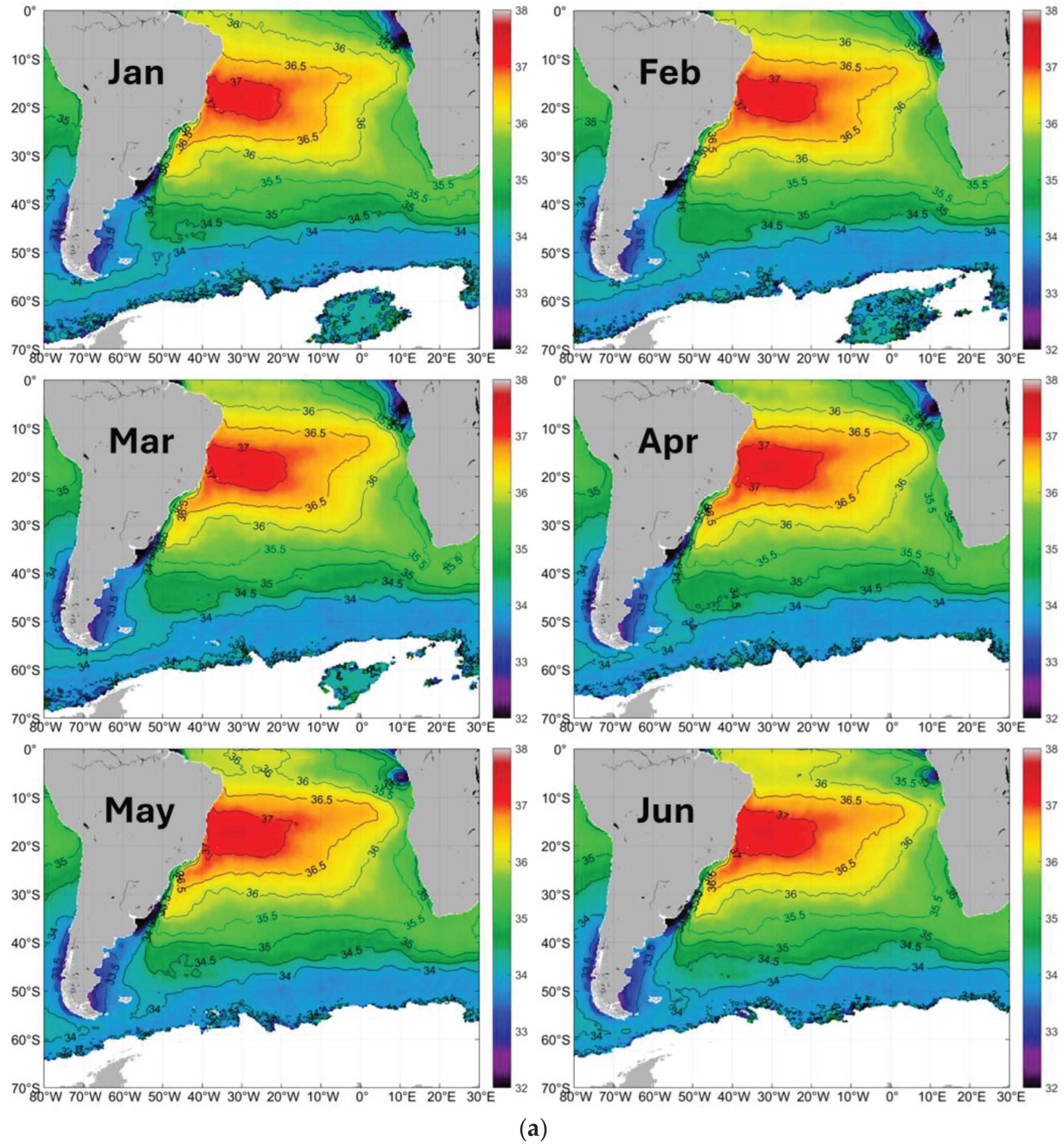
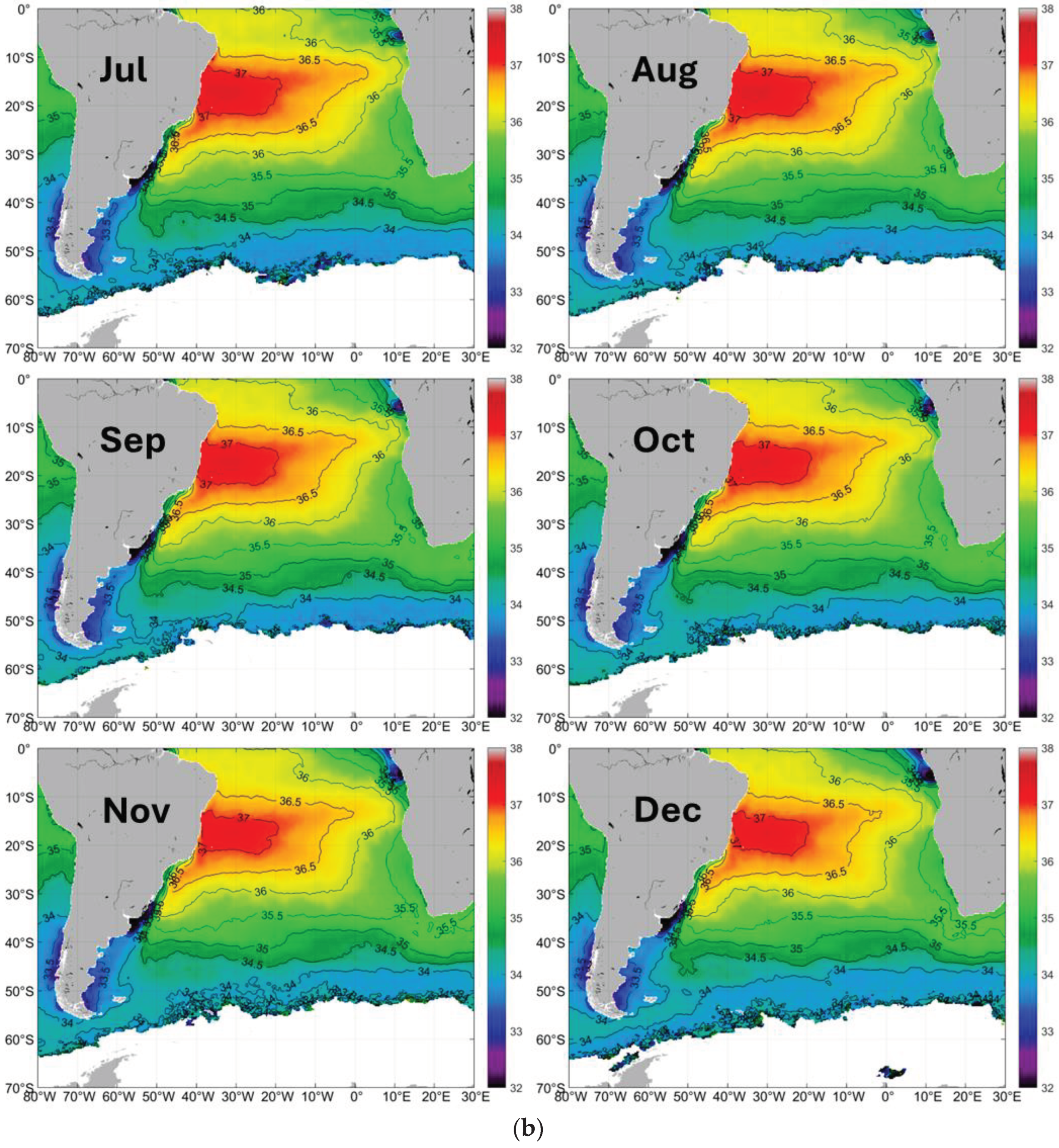
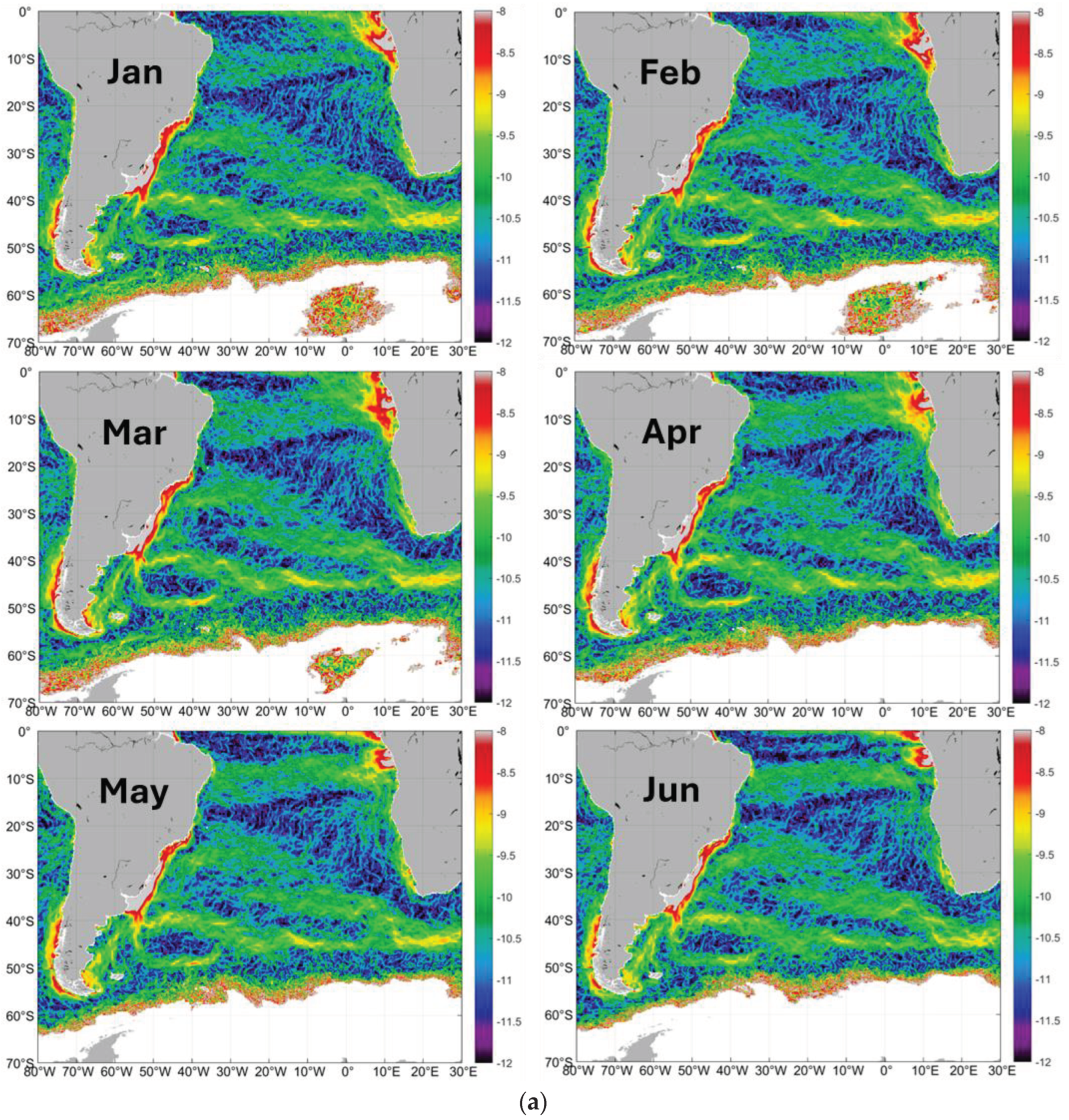
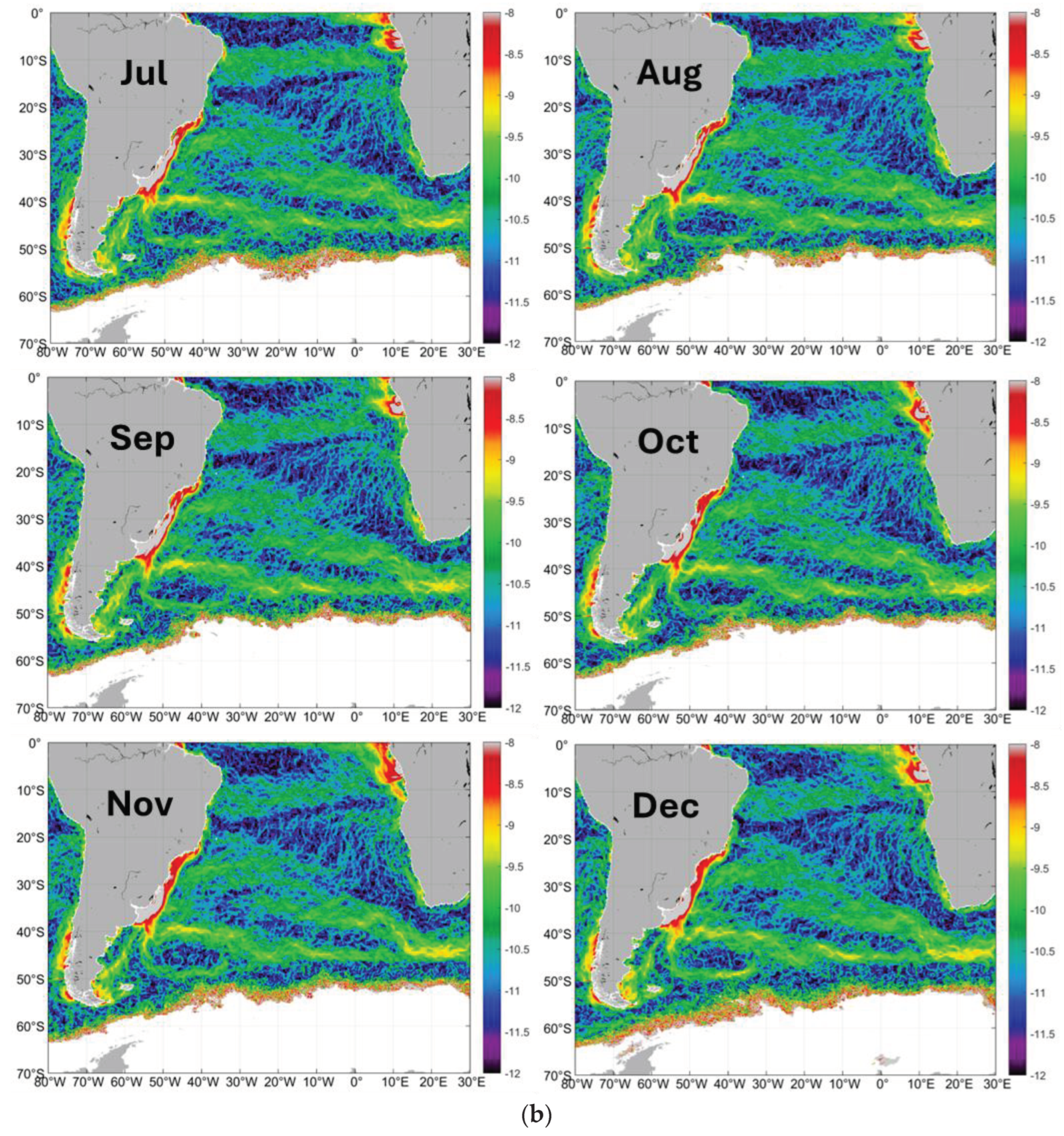
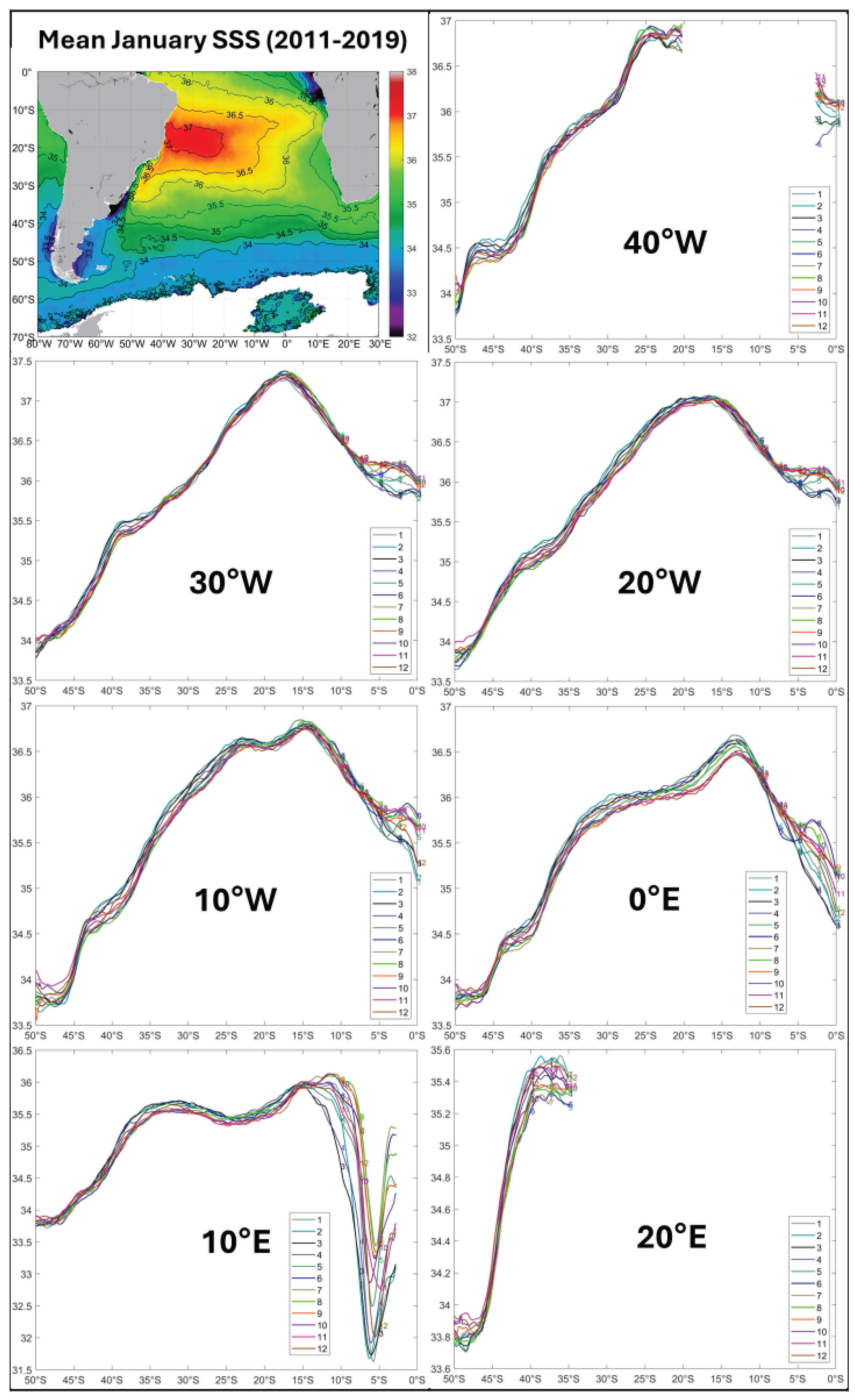
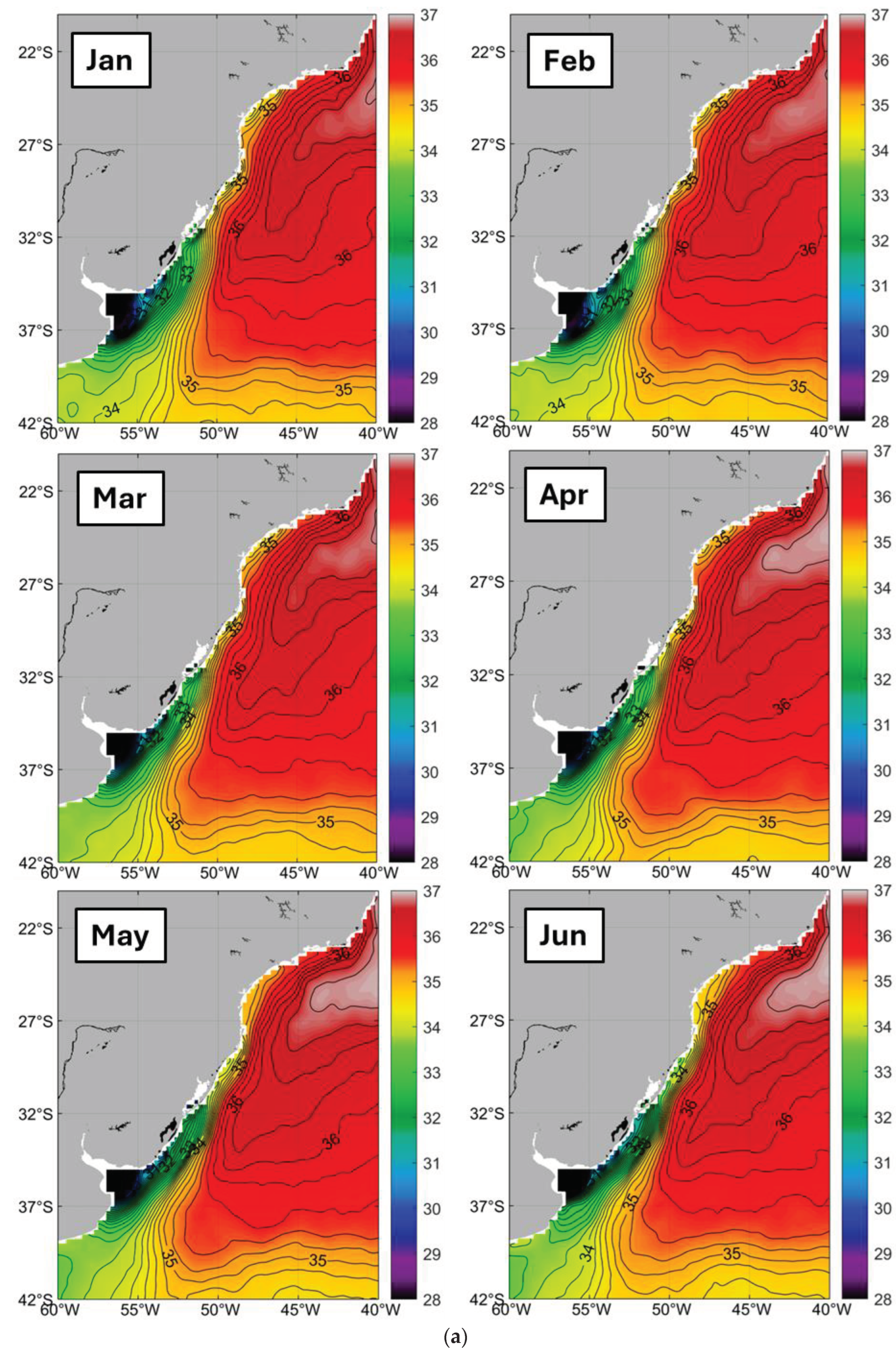
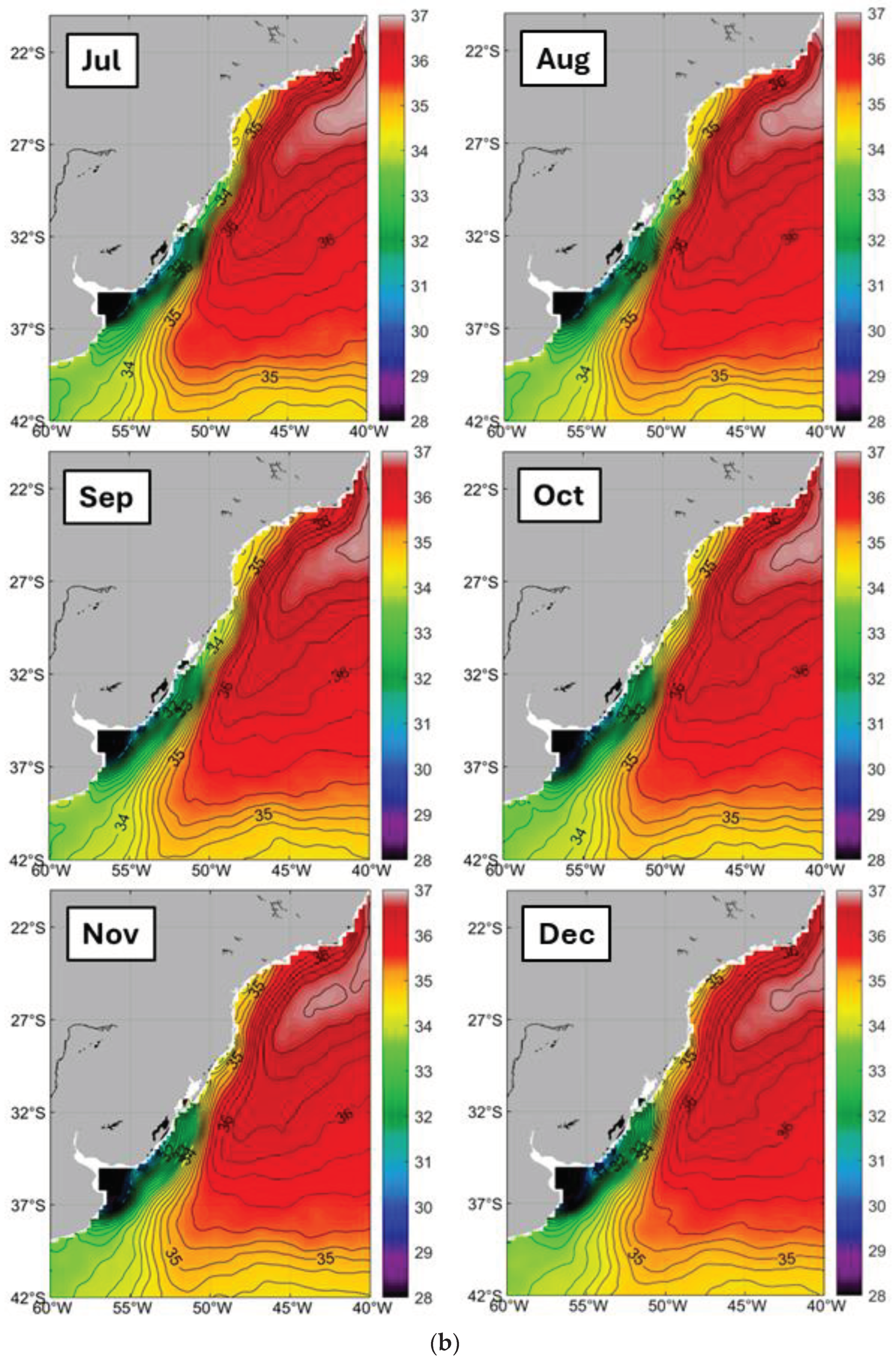
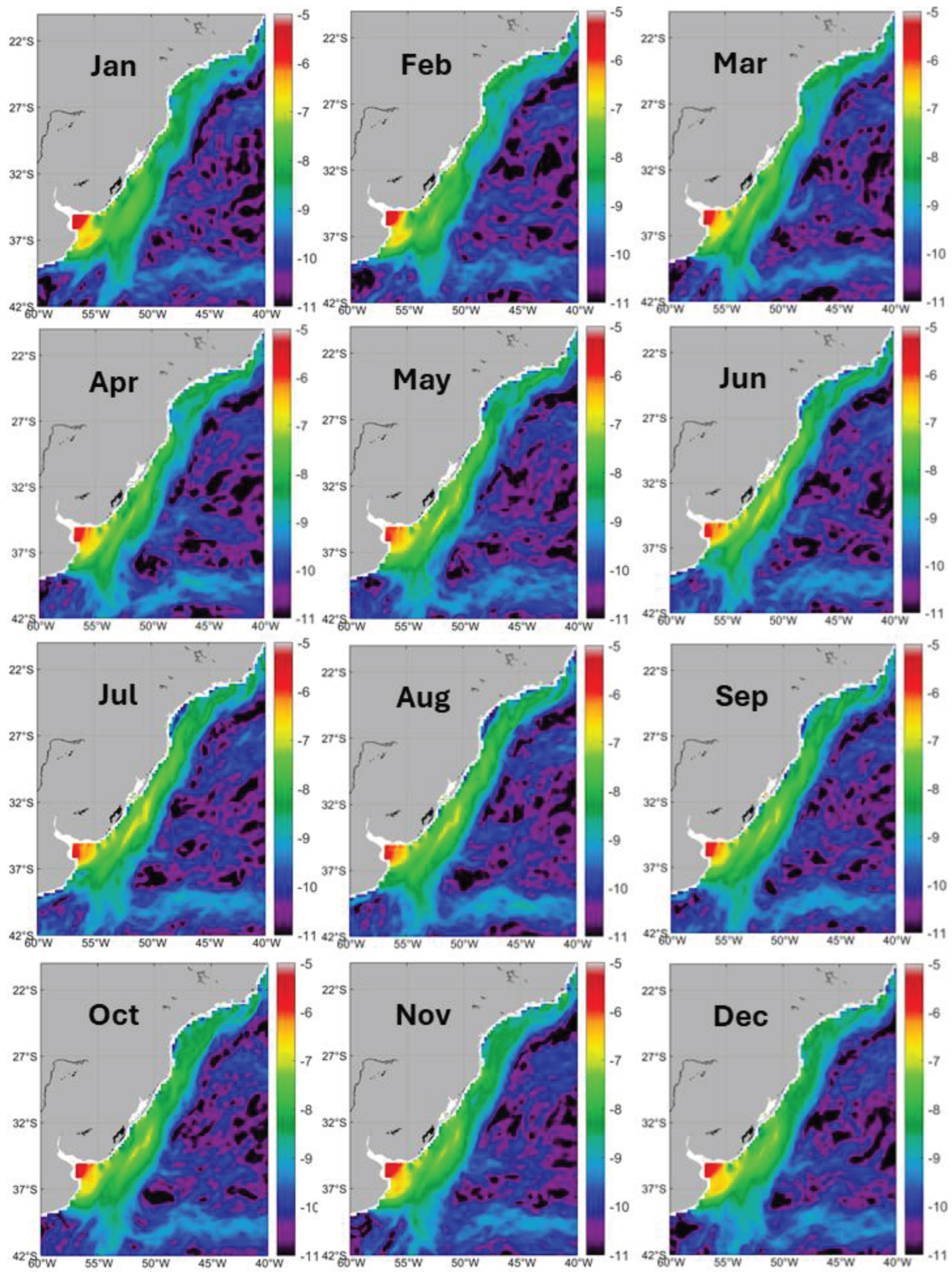
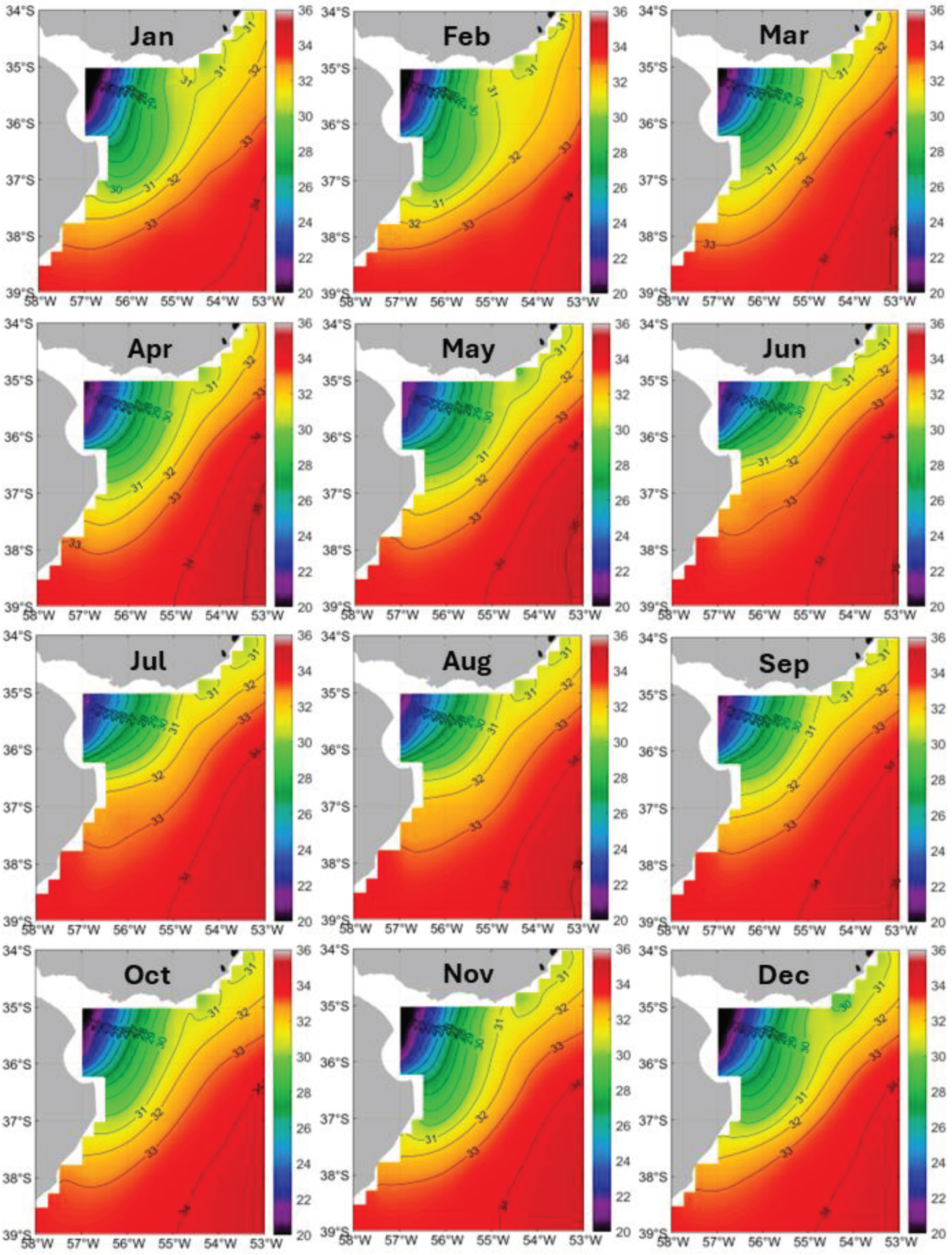
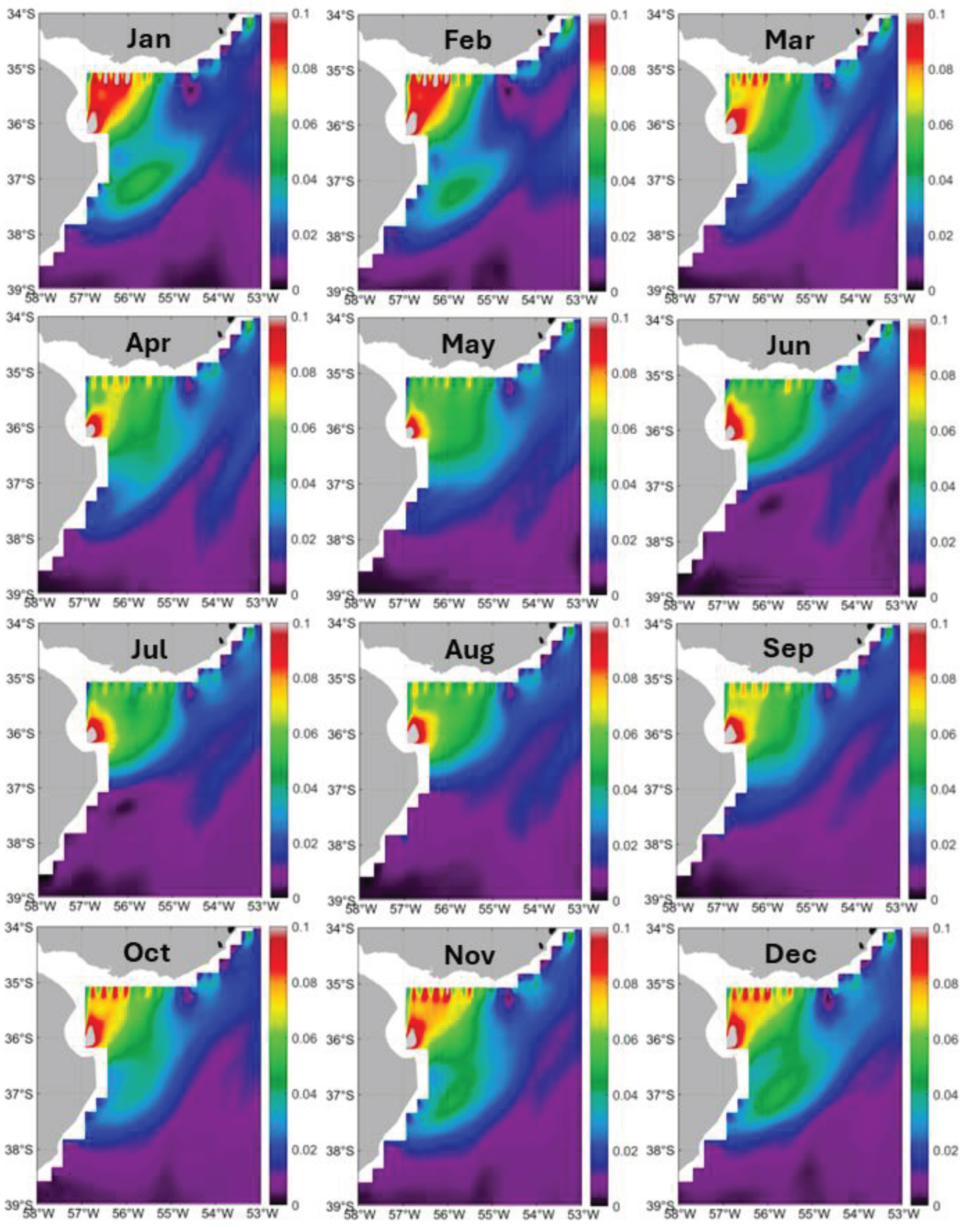
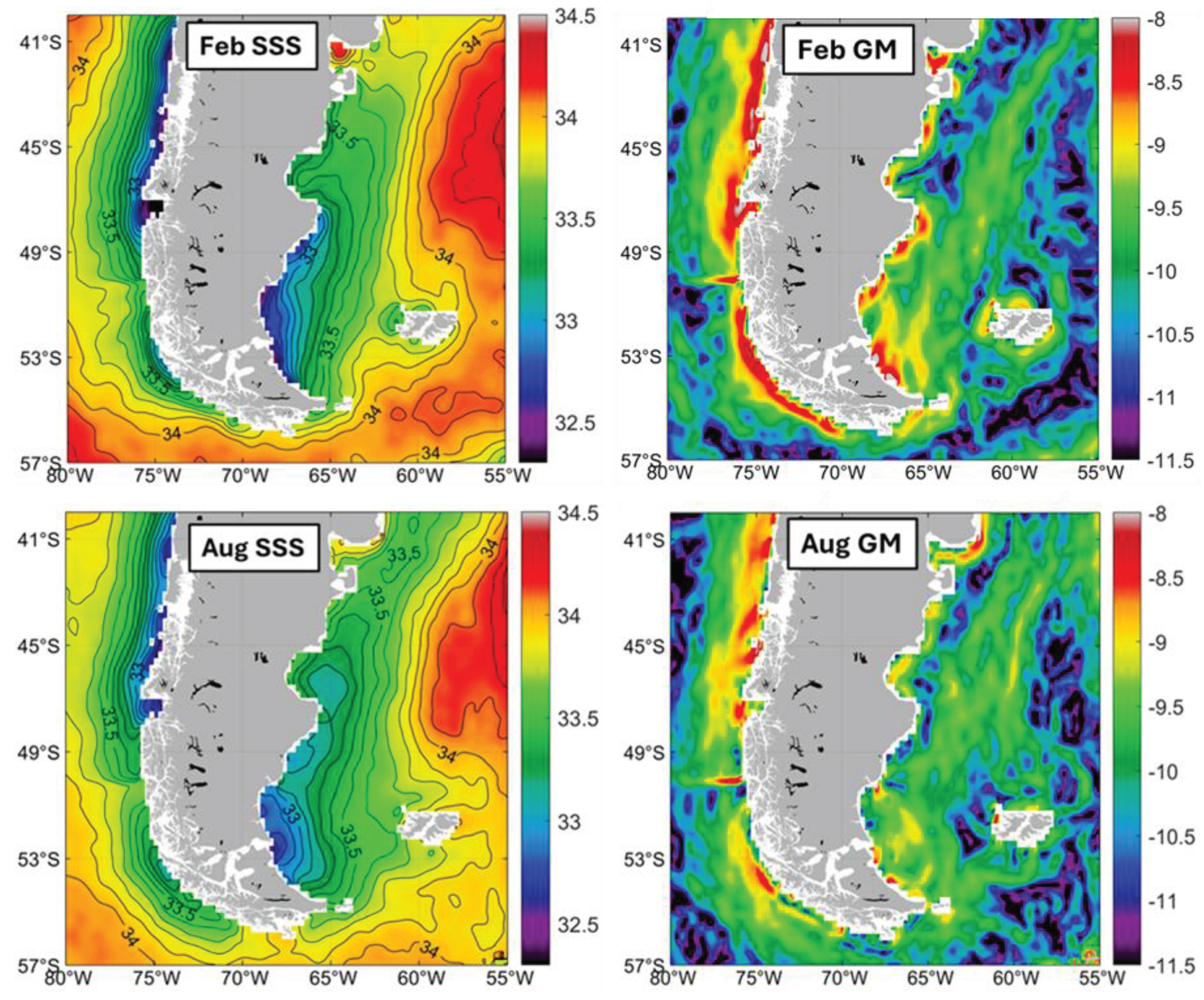
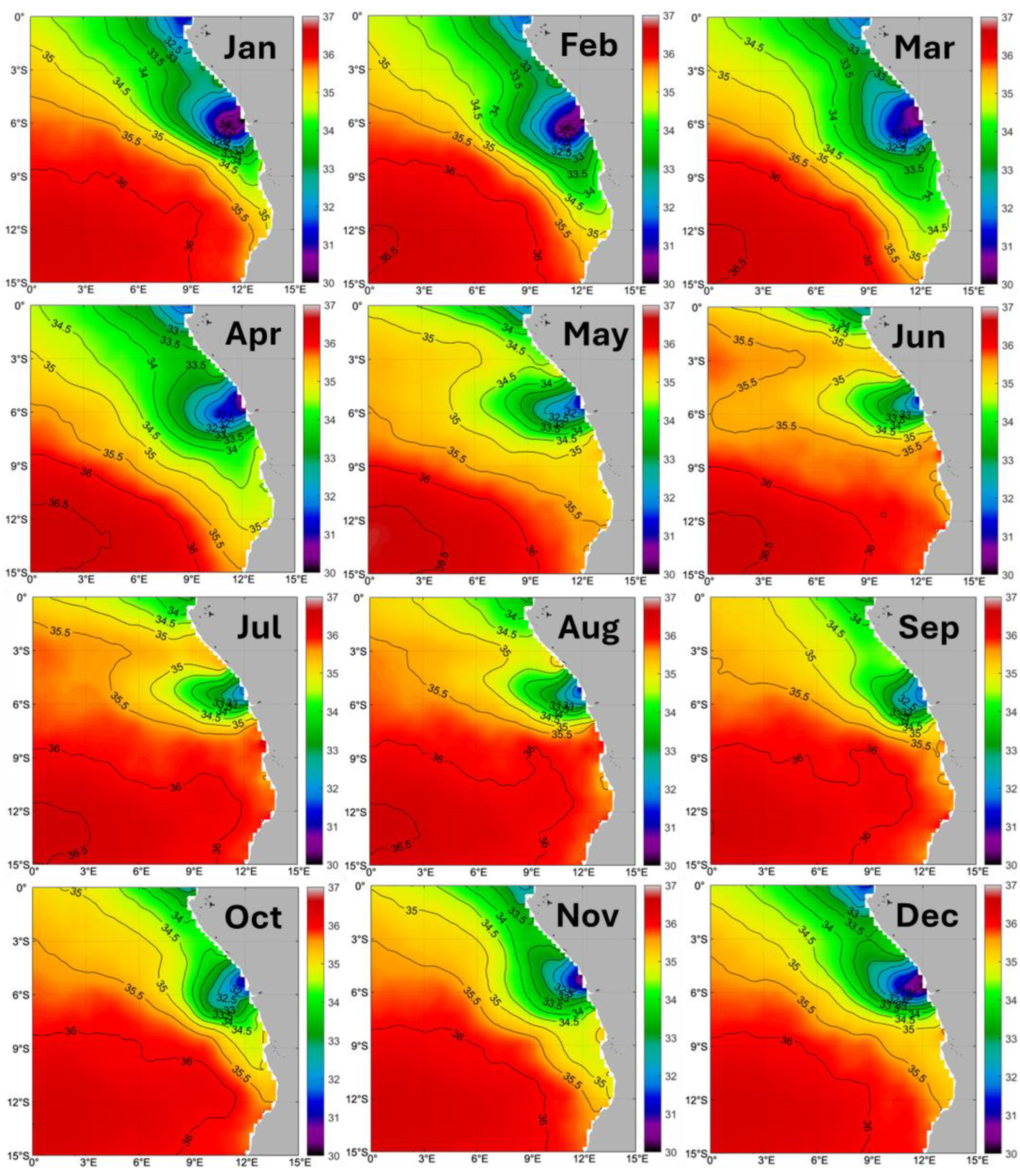
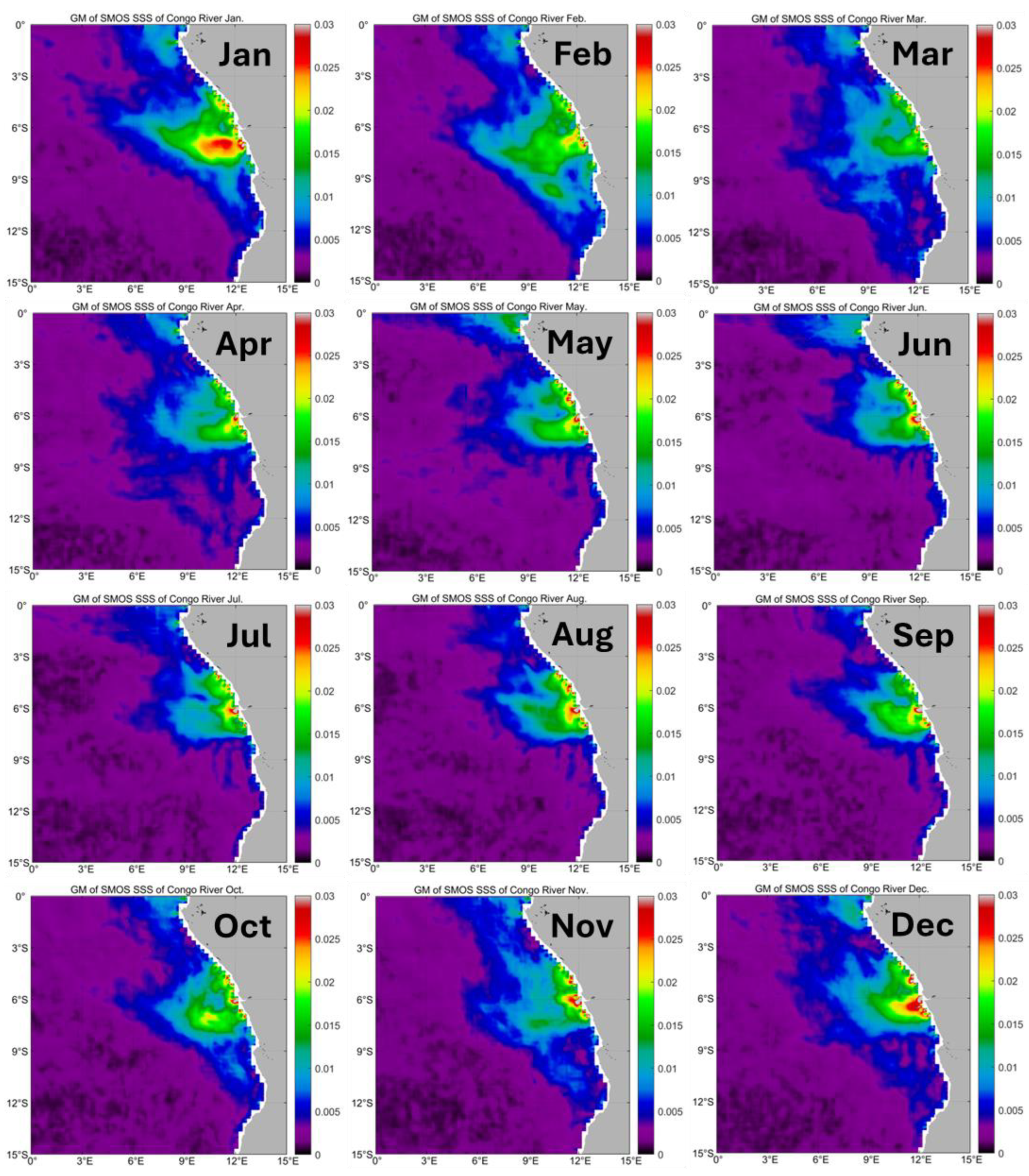
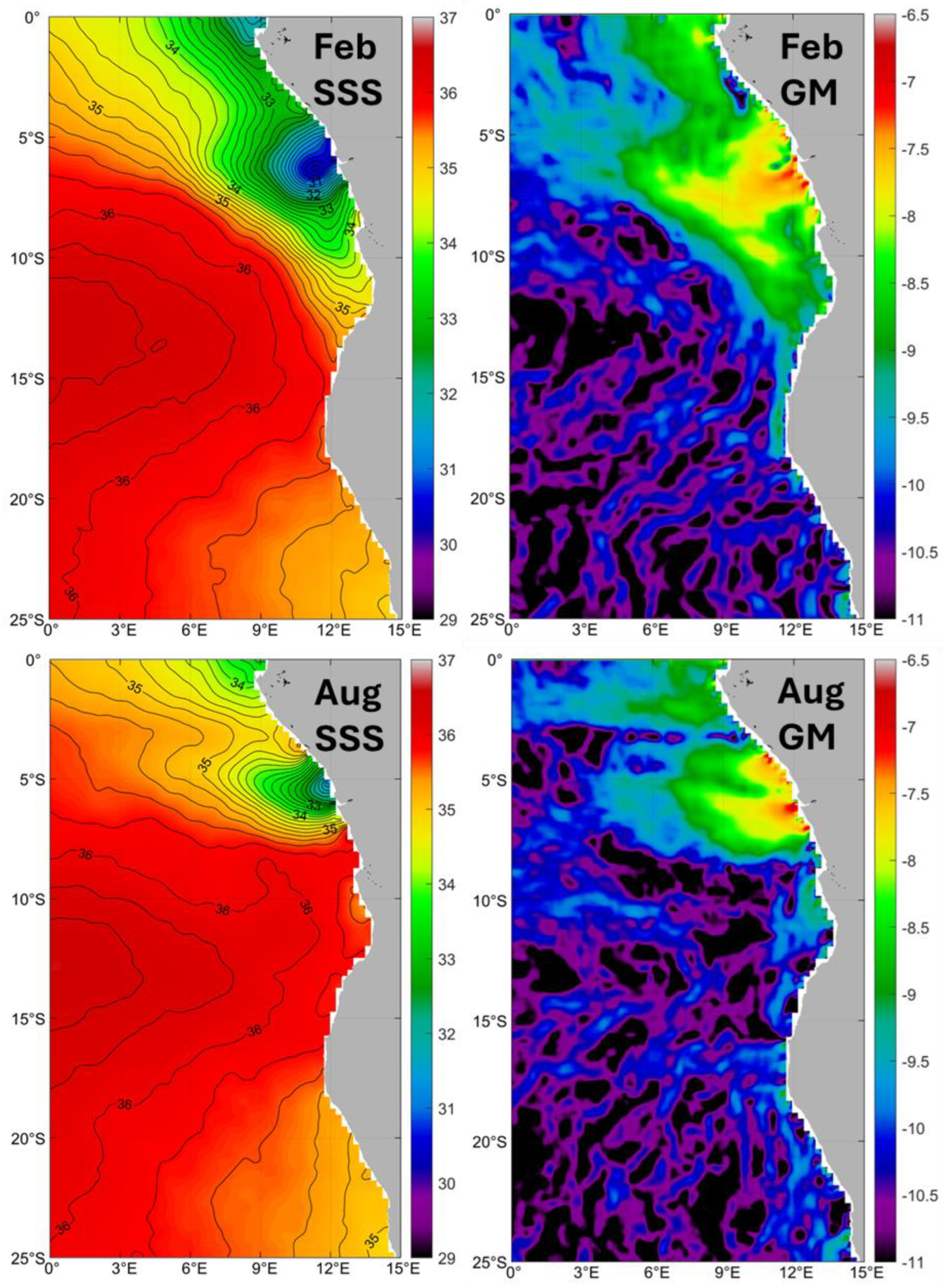

| Reference | Variable | Period | Sensor/Mission | Region |
|---|---|---|---|---|
| Allega et al. 2021 | SST | 1985-2019 | AVHRR, MODIS | Patagonian Shelf |
| Artana et al. 2018 | SST, SSH | 2007-2016 | Multisensor; Altimeters | SW Atlantic |
| Barre et al. 2006 | SST, color | 2002-2004 | MODIS, SeaWiFS | Brazil-Malvinas Confluence |
| Belkin & Shen 2024 (this study) | SSS | 2011-2019 | SMOS | South Atlantic (0-60°S) |
| Billany et al. 2010 | SSH | 1993-2007 | Altimeters | Greenwich Meridian |
| Bouali et al. 2017 | SST | 2003-2014 | MODIS | South Atlantic (0-60°S) |
| Burls & Reason 2006 | SST | 2002-2005 | TRMM, AMSR-E | South Atlantic (25 -55°S) |
| Castellanos et al. 2019 | SSS | 2011-2015 | SMOS | SW Atlantic; SE Atlantic; 12mos |
| Chao et al. 2015 | SSS | 2011-2013 | Aquarius | Congo River plume |
| Chen et al. 2019 | SST | 2002-2016 | MODIS | SE Brazil; Shelf fronts |
| Da Silveira et al. 2023 | SST SSH |
2002-2020 1993-2020 |
Multi-sensor Altimeters |
Brazil Current, 22-23°S |
| Dencausse et al. 2011 | SSH | 1992-2007 | Altimeters | SE Atlantic (5°W-35°E) |
| Dong et al. 2006 | SST | 2002-2005 | AMSR-E | Polar Front |
| Franco et al. 2008 | SST | 1985-2002 | AVHRR | Patagonian Shelf; SBF (39-44°S) |
| Franco et al. 2022 | SST SSH CHL |
1993-2019 1993-2019 2002-2020 |
Multi-sensor Altimeters MODIS |
Patagonian Shelf |
| Freeman & Lovenduski 2016 | SST | 2002-2014 | Microwave radiometers | Polar Front |
| Graham & de Boer 2013 | SST SSH |
1999-2009 1999-2009 |
AVHRR Altimeters |
Subtropical Front |
| Guerrero et al. 2014 | SSS | 2010-2013 2011-2013 |
SMOS Aquarius |
SW Atlantic |
| Hopkins et al. 2013 | SST SSS CHL SSH |
2010 | AVHRR, AMSR SMOS MODIS, MERIS Altimeters |
Congo River plume |
| Hösen et al. 2016 | SST | 2006-2011 2011-2014 |
AMSR-E/MODIS 9 km MODIS 4 km |
Benguela upwelling filaments |
| Houndegnonto et al. 2021 | SSS | 2010-2017 | SMOS | Congo River plume |
| Kim & Orsi 2014 | SSH | 1992-2011 | Altimeters | ACC fronts |
| Legeckis & Gordon 1982 | SST | 1975-1978 | VHRR | Brazil-Malvinas Confluence |
| Lorenzzetti et al. 2009 | SST | 2000-2002 | AVHRR | Brazil Current |
| Luko et al. 2021 | Velocity | 1993-2018 | Altimeters | South Equatorial Current |
| Lutjeharms & Meeuwis 1987 | SST | 1982-1985 | AVHRR | SE Atlantic; Benguela upwelling |
| Lutjeharms et al. 1993 | SST | 1988 | AVHRR | Subtropical Front |
| Martins & Stammer 2022 | SSS | 2010-2020 | SMOS, Aquarius, SMAP | Congo River plume |
| Meeuwis & Lutjeharms 1990 | SST | 1982-1985 | AVHRR | Angola-Benguela Current |
| Melnichenko et al. 2016 | SSS | 2011-2015 | Aquarius | Global |
| Meeuwis 1991 | SST | 1982-1985 | AVHRR | South Atlantic and South Indian |
| Moore et al. 1997 | SST | 1987-1988 | AVHRR | Polar Front, 90°W-20°W |
| Moore et al. 1999 | SST | 1987-1993 | AVHRR | Polar Front, Circumpolar |
| Olson et al. 1988 | SST | 1981-1987 | AVHRR | Brazil-Malvinas Confluence |
| Piola et al. 2008a | CHL | 1998-2005 | SeaWiFS | Rio de la Plata plume |
| Reul et al. 2014 | SSS | 2010-2012 | SMOS | Congo River plume Fig10 |
| Rivas 2010 | SST | 1985-2002 | AVHRR | Southwest Atlantic |
| Rivas & Pisoni 2010 | SST | 1985-2002 | AVHRR | Patagonian Shelf |
| Ruiz-Etcheverry & Saraceno 2020 | SSH | 1993-2017 | Altimeters | South Atlantic (36-55°S) |
| Saraceno et al. 2004 | SST | 1987-1995 | AVHRR | Brazil-Malvinas Confluence |
| Saraceno et al. 2005 | SST CHL |
1998-2003 1998-2003 |
AVHRR, AMSR-E SeaWiFS |
Southwest Atlantic |
| Veitch et al. 2006 | SST | 1982-1999 | AVHRR | Angola-Benguela Front |
| Wang et al. 2021 | SST CHL |
2004-2019 2007-2019 |
Multi-sensor MODIS |
SW Atlantic |
| Wang et al. 2023 | SST SSH |
2010-2018 2010-2018 |
AVHRR Altimeters |
SW Atlantic |
| Yu et al., 2015 | SSS | 2012-2013 | Aquarius | Tropical Atlantic |
Disclaimer/Publisher’s Note: The statements, opinions and data contained in all publications are solely those of the individual author(s) and contributor(s) and not of MDPI and/or the editor(s). MDPI and/or the editor(s) disclaim responsibility for any injury to people or property resulting from any ideas, methods, instructions or products referred to in the content. |
© 2024 by the authors. Licensee MDPI, Basel, Switzerland. This article is an open access article distributed under the terms and conditions of the Creative Commons Attribution (CC BY) license (https://creativecommons.org/licenses/by/4.0/).





